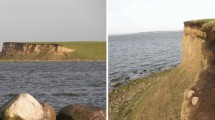Abstract
Detection of ship wakes is utterly important for ship traffic monitoring, security of sea borders, etc. Among standard detection methods there are radar and acoustic sensing, photographing, hyperspectral measurements, and water sample analysis. However, these methods are hardly suitable for detecting wakes of light high-speed boats. An alternative is optical methods, in particular laser remote sensing. In this work, laboratory experiments on laser remote sensing of water perturbed by a propeller rotating at up to 20 000 rpm are described. A long (over 5 h) decrease in the integral of the band of OH stretching vibrations inH2Omolecules in the Raman scattering spectrum and a blueshift of theOHband center by 2.5 to 3 cm−1 are demonstrated.
Similar content being viewed by others
References
S.A. Ermakov and I.A. Kapustin, “Experimental Study of Turbulent-Wake Expansion from a Surface Ship,” Izv. Atmos. Ocean. Phys. 46(4), 524 (2010).
A. Soloviev, M. Gilman, K. Young, S. Brusch, and S. Lehner, “Sonar Measurements in Ship Wakes Simultaneous with TerraSAR-X Overpasses,” IEEE Trans. Geosci. Remote Sens. 48(2), 841 (2010).
A.M. Reed and J.H. Milgram, “ShipWakes and Their Radar Images,” Ann. Rev. Fluid Mech. 34(1), 469 (2002).
H. Greidanus, “Satellite Imaging for Maritime Surveillance of the European Seas,” in Remote Sensing of the European Seas (Springer, 2008), p.343.
R. Wright, J. Deloatch, S. Osgood, and J. Yuan, “The Spectral Reflectance of ShipWakes between 400 and 900 nm,” in IEEE International Geoscience and Remote Sensing Symposium “Remote Sensing for a Dynamic Earth” (IGARSS) (22−27 July 2012, Munich, Germany), p. 4186.
X. Zhang, M. Lewis, P.W. Bissett, B. Johnson, and D. Kohler, “Optical Influence of Ship Wakes,” Appl. Opt. 43(15), 3122 (2004).
G.I. Rudenko, RF Patent No. 2407037 (2010) [in Russian].
M.V. Trevorrow, S. Vagle, and D.M. Farmer, “Acoustical Measurements of Microbubbles within Ship Wakes,” J. Acoust. Soc. Am. 95(4), 1922 (1994).
A. Sutin, A. Benilov, S.H. Roh, and Y. Nah, “Acoustic Measurements of Bubbles in the Wake of Ship Models,” in Proceedings of the 3rd International Conference on Underwater Acoustic Measurements: Technologies and Results (Napflion, Crete, 2009) p.767.
J.S. Carlton, Marine Propellers and Propulsion. 2nd ed. (Elsevier, Oxford, 2007).
K. Pardeep and R.P. Saini, “Study of Cavitation in Hydro Turbines—a Review,” Renew. Sustain. En. Rev. 14(1), 374 (2010).
G. Kuiper, “Cavitation Research and Ship Propeller Design,” Appl. Sci. Res. 58(1-4), 33 (1997).
I. Akhatov, O. Lindau, A. Topolnikov, R. Mettin, N. Vakhitova, and W. Lauterborn, “Collapse and Rebound of a Laser-Induced Cavitation Bubble,” Phys. Fluids. 13(10), 2805 (2001).
C.E. Brennen, Cavitation and Bubble Dynamics (Cambridge University Press, 2013).
W. Li, K. Yang, M. Xia, J. Rao, and W. Jang, “Influence of Characteristics of Micro-Bubble Clouds on Backscatter Lidar Signal,” Opt. Exp. 17(20), 17772 (2009).
H. Wang, Y. Wang, S. Chen, Y. Qi, and H. Liu, “Research on Polarization of Water and Bubble Scattering Echo,” Proc. SPIE. 8192, 81920M (2011).
L. Su, W. Zhao, X. Hu, D. Ren, and X. Liu, “Simple Lidar DetectingWake Profiles,” J. Opt. A: Pure Appl. Opt. 9(10), 842 (2007).
D. Zhu, X. Zhang, J. Rao, S. Jin, and K. Liu, “Research on Ship Wake Detection Mechanism Based on Optical Backscattering Effect,” Proc. SPIE. 7656, 765678 (2010).
H. Wang, Y. Wang, and S. Chen, “Influence of Wake Bubbles on Optical Impulse Scattering Echo,” Opt. Laser Technol. 44(6), 1743 (2012).
A.F. Bunkin, V.K. Klinkov, V.A. Lukyanchenko, and S.M. Pershin, “Ship Wake Detection by Raman Lidar,” Appl. Opt. 50, A86 (2011).
A.F. Bunkin, V.K. Klinkov, V.N. Lednev, D.L. Lushnikov, A.V. Marchenko, E.G. Morozov, S.M. Pershin, and R.N. Yulmetov, “Remote Sensing of Seawater and Drifting Ice in Svalbard Fjords by Compact Raman Lidar,” Appl. Opt. 51(22), 5477 (2012).
E.G. Walrafen, “Raman Spectral Studies of the Effects of Electrolytes on Water,” J. Chem. Phys. 36, 1035 (1962).
T.T. Wall and D.F. Hornig, “Raman Intensities of HDO and Structure in LiquidWater,” J. Chem. Phys. 43(6), 2079 (1965).
G.E. Walrafen, M.R. Fisher, M.S. Hokmabadi, and W.-H. Yang, “Temperature Dependence of the Lowand High-Frequency Raman Scattering from Liquid Water,” J. Chem. Phys. 85(12), 6970 (1986).
S.M. Pershin and A.F. Bunkin, “A jump in the Position and Width of the Raman Band Envelope of OH Valence Vibrations upon Phase Transitions of the First and Second Kinds in Water,” Opt. Spectrosc. 85(2), 209 (1998).
V.N. Lednev, M. Ya. Grishin, S.M. Pershin, and A.F. Bunkin, “Quantifying Raman OH-Band Spectra for RemoteWater Temperature Measurements,” Opt. Lett. 41(20), 4625 (2016).
A.F. Bunkin and S.M. Pershin, RF Patent No. 98103249 (1998) [in Russian].
A.F. Bunkin, G.A. Lyakhov, N.V. Suyazov, and S.M. Pershin, “Sequence of Water Thermodynamic Singularities in Raman Spectra,” J. Raman Spectrosc. 31(8-9), 857 (2000).
S.M. Pershin and A.F. Bunkin, “Direct Observation of the Configurational Energy Evolution and Anomalies Near Some Temperature Points inWater,” Phys.Vibr. 7(4), 217 (1999).
C.A. Angell and F. Franks, Water: A Comprehensive Treatise. Vol. 7 (Plenum, N.Y., 1982).
O. Ya. Samoilov, Structure of Aqueous Electrolyte Solutions and Ion Hydration (Izd-vo AN SSSR, Moscow, 1957) [in Russian].
G.N. Zatsepina, Water Properties and Structure (MGU,Moscow, 1974) [in Russian].
S.M. Pershin, A.F. Bunkin, and V.A. Luk’yanchenko, “Evolution of the Spectral Component of Ice in the OH Band ofWater at Temperatures from 13 to 99°C,” Quantum Electron. 40(12), 1146 (2010).
Author information
Authors and Affiliations
Corresponding author
About this article
Cite this article
Grishin, M.Y., Lednev, V.N., Pershin, S.M. et al. Lidar sensing of ship wakes. Phys. Wave Phen. 25, 225–230 (2017). https://doi.org/10.3103/S1541308X17030104
Received:
Published:
Issue Date:
DOI: https://doi.org/10.3103/S1541308X17030104




